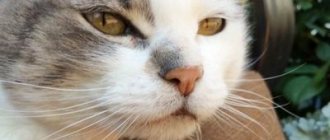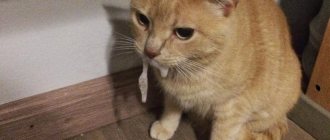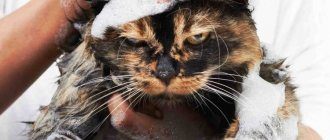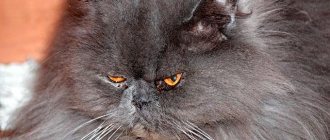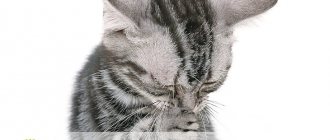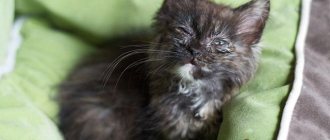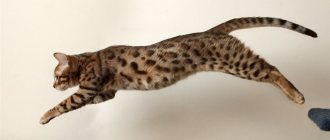Causes of hypersalivation
Conventionally, all factors causing hypersalivation are divided into three categories:
Read also: Course “How to become a sales shark”
- Physiological;
- Psychological;
- Medical.
Physiological salivation
This condition is a natural reaction of the animal to food and is characteristic of all mammals. Usually, hungry cats drool profusely, as well as when the diet changes, when food appears on the table that is more attractive in taste and smell.
A reverse “response” of the body may also be observed, for example, to taking medications with a bitter or unpleasant aftertaste. Or a cat may smell a specific plant on the street that it does not like.
Another reason, the most pleasant and harmless, is associated with the owner’s affection. When a cat relaxes from stroking and other manifestations of human attention, it begins to “flow” with pleasure in the literal sense of the word. Saliva flows from the mouth in separate drops, without a bad odor, while the animal purrs contentedly and behaves absolutely calm and balanced.
Candidiasis
A systemic drug for the treatment of candidiasis.
A whitish coating appears on the tongue, inflammation develops, the mucous membrane melts, and ulcers form.
The disease is caused by permanent inhabitants of the cat's mouth - yeast fungi, the development of which is facilitated by the following factors:
- Long-term treatment with antibiotics destroys yeast's competitors - bacteria.
- Uncontrolled use of steroidal anti-inflammatory drugs suppresses the immune system.
- Diabetes mellitus weakens the protective properties of the mucous membranes.
- When feeding cereals, excess starch occurs, which promotes the proliferation of yeast.
Be sure to read:
Third eyelid in a cat: causes, treatment at home, when no intervention is required
Additional signs are dermatitis with skin rashes, damage to the claws. Treatment consists of eliminating the underlying disease, diet therapy, and the use of external and systemic antifungal drugs.
Symptoms and signs
Heavy salivation in a cat can be accompanied by various physiological changes. They are not difficult to spot.
Read also: Basics of economics for schoolchildren
- The cat does not eat anything and is drooling. This happens with gastrointestinal diseases or viral diseases. At the same time, if you notice that your pet refuses to eat, but is drooling profusely, you should not leave everything to chance and it is better to contact a veterinarian.
- The cat stopped taking solid food, which he used to eat with great desire. This may indicate problems with the mouth, teeth, or digestive system. Also, hard pieces of food may fall out of the mouth, and the animal holds its head in an unusual position.
- Changes in cat behavior. Just like us, cats experience some discomfort when they are sick. This may affect behavior - increased aggressiveness or irritability is noticeable.
- The cat's eyes water and drool, she has difficulty swallowing food, she feels nauseous and vomits - symptoms associated with drooling that indicate digestive problems.
- The cat is drooling and has bad breath. If there are any problems in the oral cavity, the pet begins to frequently rub its face.
Prevention
The basic rules of prevention include the following points.
- Regular teeth cleaning. Accustom your pet to this procedure from childhood, then you will not have problems. Pet stores sell special brushes and pastes.
- Check the condition of your pet's oral cavity, then you can notice changes at an early stage and take appropriate measures.
- Make sure you eat properly and drink enough fluids.
- Vaccinate your pet according to age, isolate it from sick animals if necessary.
- Maintain hygiene when feeding. Wash bowls thoroughly and change water.
On our website there are more than 3,300 veterinary clinics in Moscow for you on our website biochemical blood test for cats removal of tartar for cats cleaning of teeth for cats blood tests for cats
Main diseases and conditions causing pathological hypersalivation
Diseases that can cause hypersalivation.
Trichobezoar
This is a ball of ingested hair that forms in a pet's fat cat. There is thicker content and less active peristalsis. All cats swallow hairs when licking and most often they come out naturally, but sometimes such formations are formed from them. At the same time, in addition to increased salivation, other symptoms will be present: appetite decreases and water consumption increases, the pet’s stomach swells and when palpated, bloating in the large intestine is easily detected, long-term constipation occurs with a tendency to become chronic. A hairball can lead to complete blockage of the intestinal lumen, which in turn can cause low intestinal obstruction.
This condition requires urgent surgery. To identify a trichobezoar, research methods such as ultrasound and X-ray of the abdominal cavity are used.
Poisoning
This is a rare but possible condition in cats. The most common causes are: poisonous indoor plants, medications, mercury, household chemicals, expired food, rat bait, etc. When toxic substances enter the digestive tract, the body activates the elimination system, as it tries to get rid of toxins as quickly as possible. This is accompanied not only by increased salivation, but also by vomiting, nausea, and diarrhea. The pet refuses to eat, but at the same time begins to drink a lot, breathing becomes frequent and shallow. With a high concentration of poisons in the blood, general symptoms of intoxication develop, the functioning of the central nervous system, cardiovascular and respiratory systems is disrupted. This condition requires emergency veterinary care as it can be life-threatening.
Oral diseases
They can provoke increased salivation, among the most likely are:
- Mucoceles or cysts in the salivary glands. With this disease, the lumen of the salivary ducts is blocked, which leads to excessive accumulation of saliva in the organ and the formation of one or more cysts. An additional symptom is swelling and tenderness in the gland area.
- Gingivitis is an inflammatory disease of the gums. They become red, swollen and painful. In advanced stages, the cat may lose teeth.
- Abscess in the pulp of a tooth. This is a purulent process; it can be suspected not only by hypersalivation, but also by examining the mouth. Teeth have carious cavities, chips, cracks and other enamel damage.
Infectious diseases
Sometimes there are cases when drooling is caused by infectious diseases that are dangerous to the cat's health if left untreated. These include:
- Viral leukemia (feline leukemia). This disease develops as a result of a virus entering the body that affects white blood cells (leukocytes), which are responsible for immunity. Main symptoms: chronic stomatitis and gingivitis, leading to tooth loss. A cure for this virus has not yet been developed; only symptomatic therapy is carried out, aimed at maintaining the general well-being of the pet. The lifespan of a cat with leukemia is significantly reduced.
- Rabies is an extremely dangerous and contagious disease that affects not only animals, but also people. It is characterized by an increased flow of viscous saliva with copious amounts of foam from the mouth, fear of water and the sound of transfusions, excessive aggressiveness and inappropriate behavior, and convulsions are possible. The disease is incurable at the present time in the development of medicine. In this connection, the cat is euthanized and the corpse is burned. This is done to prevent infection of people and the spread of the disease.
Allergic reactions
Not only people, but also cats have allergies. It can be food, medicinal, etc. For example, with a sudden change from the usual food to another. If excessive drooling does not go away after 2-3 days, and is accompanied by vomiting, diarrhea or constipation, it is better to return to your previous diet.
Diseases of the digestive tract and liver
In addition to increased salivation, such conditions and diseases are accompanied by an unpleasant, putrid odor from the cat’s mouth, and problems with bowel movements (diarrhea, constipation). With liver problems, both congenital and acquired, the process of neutralizing toxins entering the organ through the bloodstream is disrupted, which also provokes an increase in saliva volumes. At the same time, the pet’s nose becomes dry and warm, the tongue is coated with a thick brown coating. With congenital pathology, this condition develops in kittens in the first year of life, and with acquired pathology, this condition develops in adulthood.
Oncology
The development of tumors in the gastrointestinal tract can provoke increased salivation. This disease is difficult to diagnose due to the long absence of clear symptoms, and owners often turn to the veterinarian in advanced cases when the cat can no longer be helped. Old animals are most susceptible to this pathology, but it occurs at a young age.
Psychological reasons
There may be several of them:
- Excessive love for the owner. When stroking with pleasure, the cat may drool, which is not a sign of pathology.
- Stress. When moving, a large crowd of strangers in the apartment, the appearance of new pets, etc., the animal may feel emotional discomfort, which will manifest itself in the form of drooling.
Types of disease
Catarrhal.
During this type of stomatitis, the cat’s body temperature often rises, the mucous membrane becomes very red and swollen, and drooling practically flows in a stream. With timely treatment, there are practically no complications.
Ulcerative.
Sores appear on the cheeks and gums. The cat drinks a lot and eats practically nothing. Without treatment, the wounds enlarge and grow. The gums suffer greatly, which means the teeth become loose. Self-healing does not occur with this type, so competent therapy is necessary.
Phlegmonous.
The mucous membranes become whitish or bluish. Pus is released from the lesions. All other features are also preserved.
Gangrenous.
The most dangerous type, with it tissue necrosis already occurs; bacteria, along with the bloodstream, quickly spread throughout the body. The animal is severely depressed, all symptoms of stomatitis are clear. The lips and cheeks swell, the breath no longer just smells bad, but an unbearable stench arises. Remember, gangrene is extremely dangerous, it can lead to sepsis and death.
Causes of excessive drooling in cats
Factors influencing saliva secretion are divided into 3 groups: physiological , psychological , pathological .
The first two do not require medical attention. The third includes diseases and injuries that are diagnosed in a clinic and treated under the supervision of a doctor.
Physiological
Salivation increases due to external stimuli:
- Reaction to food . The sight and smell of food increases the secretion of gastric juice and saliva. When an animal gets used to eating at the same time, they are excreted during feeding hours and without food. Hypersalivation is noticed after unusual dishes.
- Hairballs in the gastrointestinal tract . A cat swallows hair when licking its fur coat. Salivation intensifies when they enter the esophagus due to irritation of the walls. In the stomach, the hair combines into a lump; in order to regurgitate it, additional liquid is needed.
- Medicines . Drooling increases due to the bitter, sour taste of the tablets, when licking the fur after treatment with flea drops. When an overdose of external preparations against ectoparasites occurs, the cat produces foam from its mouth, this is indicated in the instructions.
- Increased humidity and air temperature . In the heat, cats stick out their tongues and saliva drips from it. This way they restore heat exchange and escape the stuffiness.
- Pieces of food between teeth . A foreign body in the mouth irritates the mucous membranes. In an attempt to get rid of it, the cat rubs its muzzle with its paw and saliva flows profusely. In this case, the mouth is examined and the piece is carefully removed with tweezers.
Salivation returns to normal 15 to 30 minutes after the irritant is eliminated.
Psychological
Saliva is produced during moments of nervous tension; provoking factors include:
- moving, changing the usual environment;
- the appearance of other animals in the apartment;
- contact with an unfamiliar dog;
- games with children;
- visiting a veterinary clinic, medical procedures;
- travel in transport.
Hypersalivation goes away when the cat calms down and returns to its usual conditions.
Pathological
When there are no apparent reasons for ptyalism, internal disorders are suspected; they are accompanied by other unpleasant symptoms:
Pulmonary edema
How to treat a cat with diarrhea and vomiting
Dandruff
- Viral infections . Saliva is produced profusely when infected with rabies. The animal's coordination is impaired, swallowing muscles fail, convulsions occur, behavior changes - the cat hides or becomes aggressive, is afraid of light and water. With calcivirosis, the virus affects the mucous membranes and worsens health. In addition to saliva, the cat produces mucus from the nose, tears flow, and diarrhea occurs. Ulcers spread on the tongue and palate. Body temperature rises, which provokes thirst and nausea. The animal looks depressed and loses its appetite.
- Food intolerance . The reaction occurs when the food is changed, in addition to profuse salivation, the cat begins to have diarrhea and vomiting.
- Foreign body . Swallowed objects and bones injure the esophagus, stomach, and throat. The pet refuses to eat, constantly drinks, tilts its head unnaturally, coughs, and rubs its cheek on objects.
- Poisoning . Nausea with excessive saliva production is caused by spoiled food, household chemicals and cosmetics, poisonous plants and insects. With severe intoxication, vomiting and diarrhea with blood begins.
- Inflammation of the mucous membrane of the mouth, dental diseases . Hypersalivation occurs in response to the accumulation of bacteria. With stomatitis, ulcers and abscesses are noticed; with gingivitis, the gums turn red and bleed. The cat eats worse and chews food slowly. A repulsive odor appears from the mouth.
- Chemical burn . Injury occurs when acid or alkali accidentally gets on the mucous membranes after licking off iodine. The visible surfaces of the mouth swell, turn red, the tongue becomes enlarged, areas with a whitish coating and blisters appear. Breathing and heart rate increase.
- Diseases of the abdominal organs . Constant drooling and the smell of rot from the mouth accompany gastritis, ulcers, colitis, pathologies of the spleen and gall bladder. The cat refuses to eat, which leads to exhaustion.
- Other diseases . Hypersalivation sometimes begins with pyelonephritis, liver pathologies, malignant tumors, diabetes mellitus, and helminthiasis.
If the listed symptoms are noticed against the background of drooling, the cat is taken to the clinic.
Leukemia
Leukemia in cats
Leukemia in cats leads to an immunodeficiency state, one of the symptoms of which is glossitis - inflammation of the tongue. Excessive salivation develops, the hair on the neck is constantly wet, and the cat looks unkempt. The skin peels off the tongue, the surface becomes smooth, and ulcers form. Another name is lymphosarcoma.
Animals under three years of age are susceptible. The leukemia virus is extremely contagious, however, the disease occurs when the immune system fails, caused by frequent stressful situations, improper living conditions and feeding.
In some cases, the animal copes with the virus without any treatment and clinical symptoms do not occur or appear sluggishly.
An alternative situation is that the pet’s condition quickly deteriorates and it dies before the onset of characteristic signs. Glossitis develops during the chronic course of the disease.
Other symptoms:
- anemia - weakness, pallor of mucous membranes;
- spontaneous bleeding;
- cough, runny nose;
- pregnant animals abort;
- lymph nodes enlarge.
The diagnosis is made by clinical signs, blood smear microscopy, serological reactions - RID, PCR. Symptomatic treatment can prolong life. If tumors have formed, the prognosis is unfavorable.
Prevention consists of comfortable housing, a balanced diet, and regular treatments against arthropods and helminths. The Purevax FeLV vaccine protects against leukemia.
What should the owner do?
Possible actions on the part of the owner depend on the condition of the animal. If it is healthy, and all the signs of a physiological cause are present, the problem that has arisen will resolve itself.
If you are prone to motion sickness in transport, consult your veterinarian to select tablets. Give them to your cat before every trip.
An object stuck in the teeth should be carefully removed with tweezers. After manipulation, treat the mucous membranes with Miramistin or chlorhexidine to avoid infection. If the foreign body is deeply located, it is better not to take independent actions, since any mistake can lead to injuries to the larynx.
In all other cases, it is recommended to immediately contact a veterinarian. Remember that when infected with certain viruses and helminths, a cat becomes dangerous to humans.
Preventing excessive drooling in cats
There are some things you can do to minimize the risk of hypersalivation:
- Vaccinate all animals living in the same area against rabies and the most common infections, regularly deworm them and treat them against ectoparasites.
- Maintain good oral hygiene (brush your teeth, use special foods and products to maintain oral hygiene). For example, toothpastes “Globalvet”, “Veda”, “Klini”, “Beafar”, “8 in 1”.
- Visit veterinary clinics periodically to have your pet examined. The “tail” needs to undergo a preventive examination at least once a year.
- Prevent your cat from having access to caustic or toxic substances and dangerous plants.
- Keep the area where your pet lives clean.
- Remove all small objects, threads, needles, rain, etc. from your pet’s access area
Health to you and your cats!
Treatment
Stomatitis brings a lot of discomfort and pain to the cat, so it is necessary to go to the clinic so that the veterinarian can accurately determine the cause of the disease. With secondary stomatitis, treatment takes quite a long time.
Biochemical blood and urine tests and oral culture are required. In severe situations, even surgical treatment, tooth extraction under local or general anesthesia, removal of tartar, etc. are indicated.
For mild forms of the disease, therapy is carried out at home. A thorough examination is necessary; stomatitis may be caused by an object stuck in the mouth.
After eating, you will need to irrigate or rinse your pet's mouth with infusions of herbs: chamomile, oak bark, St. John's wort. It is possible to use local antiseptics, such as Chlorhexidine, Miramistin. You can also use weak solutions of potassium permanganate or hydrogen peroxide, but it is better not to abuse them, otherwise you may injure the mucous membrane even worse.
For small ulcers, you can use special ointments (Actovegin, Mexidol, Levomekol, Cholisal).
A special diet is required. Do not feed your cat dry food or hard foods. It is better to use soft, ground food.
For a bacterial infection, the treatment regimen includes broad-spectrum antibiotics, which will be prescribed by a specialist, because it is important to choose the right dosage and duration of use.
For fungus, antifungal agents are prescribed.
Additionally, painkillers and antipyretics are used.
The doctor will recommend that you strengthen your pet’s immunity and prescribe special supplements and vitamins.
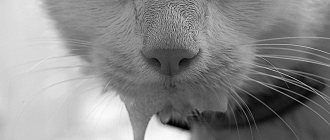
![Why is the cat drooling: [Find out the reason, What to do]](https://koriiza.ru/wp-content/uploads/pochemu-u-kota-tekut-slyuni-uznajte-prichinu-chto-delat-330x140.jpg)
